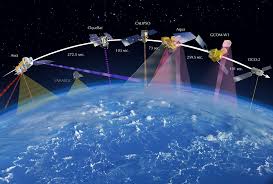Earth Observation Satellite Market Outlook
The Earth Observation (EO) satellite market is on an undeniable upward trajectory. Fueled by advancements in satellite technology, increasing demand for geospatial data across diverse sectors, and a growing awareness of the critical role EO plays in addressing global challenges, the market is poised for significant expansion. Recent projections indicate a robust future, with the market size anticipated to reach a substantial $0.5 billion by 2030, registering a compelling Compound Annual Growth Rate (CAGR) of 6.90% during the analysis period of 2024-2032. This growth narrative is underpinned by a confluence of factors that are reshaping how we monitor, understand, and interact with our planet.
At its core, the Earth Observation satellite market encompasses the design, manufacturing, launch, and operation of satellites specifically purposed for observing the Earth’s surface and atmosphere. These sophisticated platforms are equipped with a range of sensors that capture data across various spectral bands, providing invaluable insights into physical, chemical, and biological processes. The data acquired is then processed, analyzed, and disseminated to end-users across a multitude of applications.
Several key drivers are propelling the impressive growth anticipated in this market. Firstly, the increasing demand for high-resolution and high-frequency imagery is a significant factor. As applications become more sophisticated, the need for detailed and timely information about land use, infrastructure development, environmental changes, and disaster events intensifies. Advancements in sensor technology are enabling the capture of increasingly granular data, while constellations of smaller, more agile satellites are improving revisit times, making near real-time monitoring a reality.
Secondly, the proliferation of value-added services is expanding the market’s reach. Raw satellite imagery, while valuable, often requires specialized processing and analysis to extract actionable insights. A growing ecosystem of companies is developing sophisticated algorithms and platforms to transform this raw data into tailored information products and services. These include services for precision agriculture, urban planning, forestry management, maritime surveillance, and climate monitoring, making EO data more accessible and user-friendly for a wider range of industries.
Thirdly, the growing awareness of environmental challenges and the need for sustainable development is a crucial catalyst. Earth observation satellites play a vital role in monitoring climate change indicators, tracking deforestation, assessing water resources, and monitoring pollution levels. The data they provide is essential for informed decision-making by governments, international organizations, and researchers working towards a more sustainable future. The increasing focus on environmental, social, and governance (ESG) factors is further driving the adoption of EO data for monitoring and reporting.
Furthermore, technological advancements are continuously pushing the boundaries of what is possible in Earth observation. Innovations in satellite miniaturization, such as CubeSats and SmallSats, are reducing launch costs and enabling the deployment of large constellations. Improvements in sensor technology are leading to higher spatial, spectral, and temporal resolution. The integration of artificial intelligence (AI) and machine learning (ML) is revolutionizing data processing and analysis, enabling the extraction of more complex patterns and insights from vast datasets. Cloud computing platforms are also facilitating the storage, processing, and dissemination of EO data on a large scale.
The Earth Observation satellite market is characterized by a diverse range of applications across various sectors. Agriculture benefits immensely from EO data for crop monitoring, yield prediction, irrigation management, and precision farming techniques. In urban planning and infrastructure management, satellite imagery aids in mapping urban sprawl, monitoring construction progress, and assessing the impact of infrastructure projects. The environmental monitoring sector relies heavily on EO data for tracking deforestation, monitoring ice caps and glaciers, assessing the health of ecosystems, and detecting oil spills and other pollution events. Disaster management is another critical application area, with satellites providing crucial information for early warning, damage assessment, and relief efforts during natural disasters. Defense and security agencies utilize EO data for surveillance, reconnaissance, and border monitoring. Furthermore, emerging applications in areas like insurance (for risk assessment and damage claims) and mining (for exploration and environmental monitoring) are further expanding the market’s potential.
The projected CAGR of 6.90% during 2024-2032 signifies a steady and robust growth trajectory. This growth will be driven by the continued adoption of EO data across existing and emerging applications, coupled with the increasing availability of more sophisticated and affordable data and services. The decreasing cost of satellite launches and the rise of commercial EO companies are also contributing to this positive outlook.
Get a Quote – Request a price quote for the report or specific research services.
However, the market also faces certain challenges. The sheer volume of data generated by Earth observation satellites requires robust infrastructure for storage, processing, and analysis. Ensuring data interoperability and standardization across different satellite missions and data providers is also crucial for seamless integration and utilization. Furthermore, the cost of acquiring and processing high-resolution imagery can still be a barrier for some potential users. Addressing these challenges through technological advancements, standardization efforts, and the development of more accessible data platforms will be key to unlocking the full potential of the Earth Observation satellite market.
In conclusion, the Earth Observation satellite market is entering a dynamic and high-growth phase. The projected market size of $0.5 billion by 2030, coupled with a healthy CAGR of 6.90%, underscores the increasing recognition of the invaluable insights that EO data provides across a multitude of sectors. Driven by technological innovation, expanding applications, and a growing awareness of global challenges, the market is poised to play an increasingly critical role in how we understand and manage our planet. As data accessibility improves and value-added services become more sophisticated, the expanding horizon of the Earth Observation satellite market promises significant opportunities for innovation and impact in the years to come.
